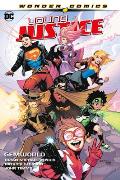In 1986 Tom Lyle, an aspiring comic-book artist in his thirties, went to a comics convention in Philadelphia. There he met Chuck Dixon, a young writer who was scripting
Air Boy for Eclipse. Based on Lyle’s samples, Dixon got him the job of penciler on a related title,
Sky Wolf. In a
chat with Comics Interview magazine, Lyle credited that as “the event that triggered my career” in comics.
Lyle was recruited by DC Comics to draw
Starman in 1988. After a couple of years, as he was wrapping up that assignment, Lyle asked Batman group editor Dennis O’Neil if he had any openings. O’Neil was planning a miniseries focusing the newly created Robin, Tim Drake.
“I’ve never been real thrilled with the Robins,” Lyle told his interviewer. “Dick Grayson, the original Robin, I couldn’t have given a flip about when I was a kid; it was like, ‘Get out of the way, kid, I want to see Batman.” But a job was a job.
O’Neil’s team wanted to make Robin into a martial-arts expert, so they needed a writer who understood the martial arts. Lyle suggested Dixon. He got the assignment and went on to be DC’s most productive writer of the decade. (On the
occasion of his 40,000th comics page in 2017, Bleeding Cool noted Dixon wrote 106 issues of
Robin, 89 issues of
Detective Comics, 77 issues of
Nightwing, 46 issues of
Birds Of Prey, and 22 issues of
Catwoman, to name a few.)
Dixon and Lyle’s first issue of the first
Robin series carried a cover date of January 1991. The character of Tim Drake had been created by Marv Wolfman in issues drawn by George Pérez, Jim Aparo, and Norm Breyfogle, and his costume was designed by Neal Adams. But Dixon and Lyle’s portrayal fleshed him out by showing him on his own. Lyle was especially good at portraying Tim as a thirteen-year-old, lithe but not a powerhouse, the littlest guy in the fight who needed to think harder than anyone else to stay alive.
In the gritty, pouched, and overpumped 1990s,
Robin was the equivalent of counterprogramming on broadcast television—standing out by doing something different. And it worked. According to Lyle, DC expected to sell about 200,000 copies of the first issue of the
Robin miniseries. Instead, it sold three times that number.
DC asked the Dixon-Lyle team for a second miniseries about Tim Drake going up against the Joker, issued at the end of 1991. Then came a third, featuring the character the Huntress for an interesting contrast. That was the height of the speculative boom, and those magazines are festooned with holograms and other gimmicks.
Dixon and Lyle also collaborated on issues of
Batman and
Detective Comics showing Batman and Robin together. One of those magazines introduced Stephanie Brown as the Spoiler, who went on to become Tim Drake’s love interest, a fan favorite, and eventually Robin and Batgirl herself for limited periods. Lyle was also the artist for the first
Robin Annual and the
1992 public service ad in which Tim decides to learn the facts about AIDS.
During that time, Lyle also plotted and penciled the early issues of
The Comet for DC’s Impact imprint. In 1993 he started working for Marvel Comics on Spider-Man stories. That same year, DC launched the
Robin monthly series with Dixon as regular scripter.
After another ten years or so, Lyle left monthly comics to become an art teacher at the Savannah College of Art and Design. Earlier this year he suffered an aneurysm, and last week he died, aged 66. Friends and fans have set up a
Go Fund Me page for his family.







